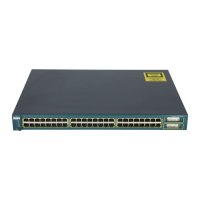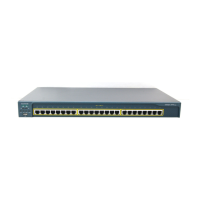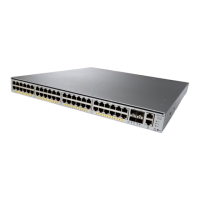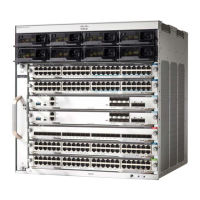17-19
Catalyst 2950 and Catalyst 2955 Switch Software Configuration Guide
78-11380-10
Chapter 17 Configuring VLANs
Configuring VLAN Trunks
To return an interface to its default configuration, use the default interface interface-id interface
configuration command. To reset all trunking characteristics of a trunking interface to the defaults, use
the no switchport trunk interface configuration command. To disable trunking, use the switchport
mode access interface configuration command to configure the port as a static-access port.
This example shows how to configure a port as an 802.1Q trunk. The example assumes that the neighbor
interface is configured to support 802.1Q trunking.
Switch# configure terminal
Enter configuration commands, one per line. End with CNTL/Z.
Switch(config)# interface fastethernet0/4
Switch(config-if)# switchport mode dynamic desirable
Switch(config-if)# end
Defining the Allowed VLANs on a Trunk
By default, a trunk port sends traffic to and receives traffic from all VLANs. All VLAN IDs, 1 to 4094
when the EI is installed, and 1 to 1005 when the SI is installed, are allowed on each trunk. However, you
can remove VLANs from the allowed list, preventing traffic from those VLANs from passing over the
trunk. To restrict the traffic a trunk carries, use the switchport trunk allowed vlan remove vlan-list
interface configuration command to remove specific VLANs from the allowed list.
To reduce the risk of spanning-tree loops or storms, you can disable VLAN 1 on any individual VLAN
trunk port by removing VLAN 1 from the allowed list. This is known as VLAN 1 minimization. VLAN 1
minimization disables VLAN 1 (the default VLAN on all Cisco switch trunk ports) on an individual
VLAN trunk link. As a result, no user traffic, including spanning-tree advertisements, is sent or received
on VLAN 1.
When you remove VLAN 1 from a trunk port, the interface continues to send and receive management
traffic, for example, Cisco Discovery Protocol (CDP), Port Aggregation Protocol (PAgP), Link
Aggregation Control Protocol (LACP), Dynamic Trunking Protocol (DTP), and VLAN Trunking
Protocol (VTP) in VLAN 1.
If a trunk port with VLAN 1 disabled is converted to a nontrunk port, it is added to the access VLAN. If
the access VLAN is set to 1, the port is added to VLAN 1, regardless of the switchport trunk allowed
setting. The same is true for any VLAN that has been disabled on the port.
A trunk port can become a member of a VLAN if the VLAN is enabled, if VTP knows of the VLAN,
and if the VLAN is in the allowed list for the port. When VTP detects a newly enabled VLAN and the
VLAN is in the allowed list for a trunk port, the trunk port automatically becomes a member of the
enabled VLAN. When VTP detects a new VLAN and the VLAN is not in the allowed list for a trunk
port, the trunk port does not become a member of the new VLAN.
Beginning in privileged EXEC mode, follow these steps to modify the allowed list of an 802.1Q trunk:
Step 8
show interfaces interface-id trunk Display the trunk configuration of the interface.
Step 9
copy running-config startup-config (Optional) Save your entries in the configuration file.
Command Purpose
Command Purpose
Step 1
configure terminal Enter global configuration mode.
Step 2
interface interface-id Enter interface configuration mode and the port to be configured.
Step 3
switchport mode trunk Configure the interface as a VLAN trunk port.
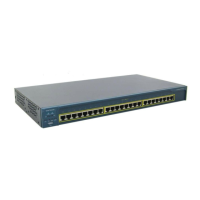
